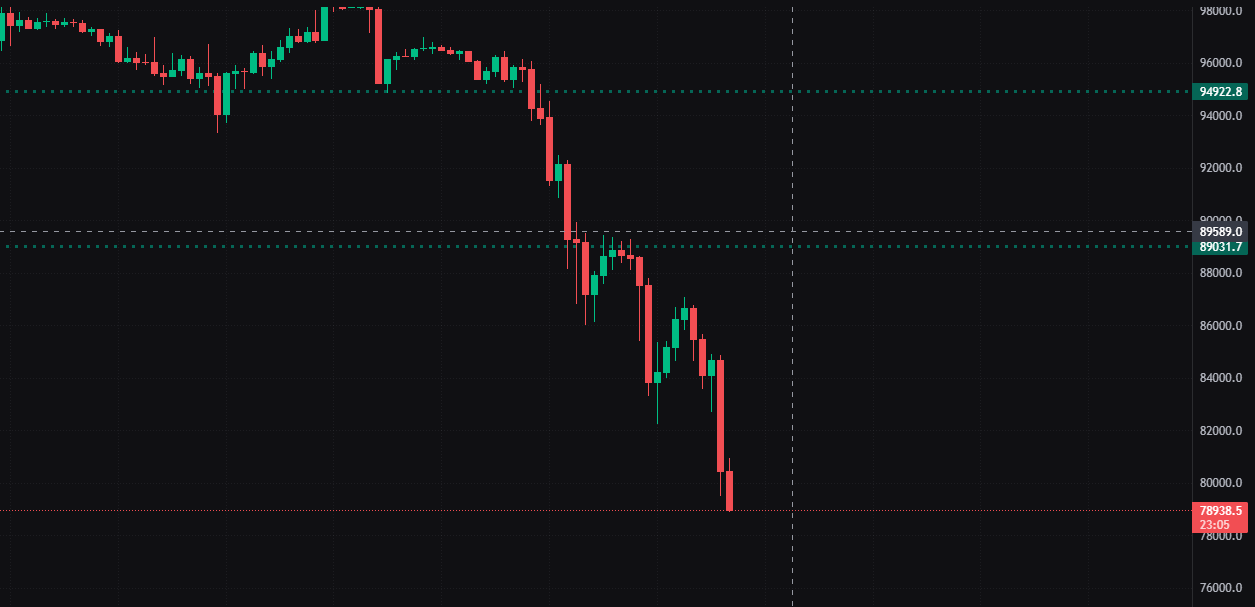Discover the reasons behind the Bitcoin Crash of 24% and explore historical data, technical analysis, and institutional trends that could signal a major recovery. Is this a dip or the start of a larger trend?
Bitcoin’s price volatility has once again captured the attention of investors worldwide. Following a 24% correction from its all-time high, many are wondering: Is this a temporary setback or a major trend reversal? By analyzing historical data, technical indicators, and market trends, we can gain insights into Bitcoin’s potential path forward.
Bitcoin Crash and Signs of Recovery
One of the key factors contributing to Bitcoin’s recent correction is external economic uncertainty, including trade tensions involving Donald Trump. However, history suggests that such downturns often precede major rallies.
The Bitcoin Fear and Greed Index dropped to 10, reflecting extreme fear in the market. Historically, such low levels have led to significant price rebounds. Consider these past examples:
- December 2018: Bitcoin surged over 330% within two months after hitting extreme fear levels.
- March 2020 (COVID Crash): Bitcoin rebounded over 75% within just a month.
- May 2021: Bitcoin experienced a 33% price surge within two months.
These data points indicate that extreme fear in the market often presents a strong buying opportunity for long-term investors.
Technical Analysis: Key Support and Resistance Levels of Bitcoin

From a technical standpoint, Bitcoin is currently bouncing off the 200-day Simple Moving Average (SMA)—a critical indicator for determining bullish or bearish trends.
- If Bitcoin maintains above the 200-day SMA, it could signal the continuation of the bull market.
- If it drops below, the next key support level is around $77,700, a historically strong demand zone.
Additionally, the Relative Strength Index (RSI) is currently oversold at 24, suggesting Bitcoin is likely to experience a short-term bounce.
Stablecoins & Institutional Adoption: A Game-Changer?
One of the most significant developments in the crypto space is the growing institutional interest in stablecoins.
- Bank of America is reportedly considering launching a USD-pegged stablecoin, similar to money market funds or traditional bank accounts.
- Stablecoin legislation is expected within the next four to six months, paving the way for more institutional players to enter the market.
This institutional push could boost Bitcoin and the broader crypto sector by providing liquidity and regulatory clarity.
Web3 and Music: The Role of Decentralized Platforms
The Web3 revolution is making waves in the music industry as well. Snoop Dogg recently released a single on Tune.fm, a decentralized music streaming platform built on the Hedera blockchain.
This move highlights how blockchain technology is transforming industries beyond finance, enabling artists to regain control over their content and revenue streams.
Crypto Intelligence & On-Chain Data: The Cookie3 Revolution
The crypto space is rapidly evolving, and platforms like Cookie3 are driving innovation by providing on-chain and social intelligence for AI-driven trading and analysis.
- Cookie3 v1.0 aims to make crypto intelligence freely accessible, categorizing data into key sectors such as AI, infrastructure, and meme coins.
- This initiative could enhance transparency and decision-making in the crypto industry.
Solana’s Undervalued Status: A Buying Opportunity?
Solana has been two standard deviations oversold based on its log regression channel, with an RSI at its lowest since 2022.
- Historically, buying at such levels has yielded substantial gains within a month.
- If past trends hold, Solana’s price could experience significant upside in the near term.
MetaMask & Linea: Bridging Crypto and Traditional Finance
MetaMask is taking a step towards mainstream adoption by launching a debit card in collaboration with Ethereum L2 Linea.
- This allows users to earn Foxy rewards while making everyday purchases.
- The move mirrors Coinbase’s strategy, which encourages users to engage with its Base network.
Such integrations are crucial for expanding crypto adoption beyond traditional trading.
Copy Trading: A New Trend on Bitun
Crypto trading is becoming more accessible through features like copy trading on Bitun.
- Users can follow expert traders and replicate their trades automatically.
- Traders who lead successful strategies can earn a share of profits.
- This feature is ideal for beginners looking to learn from experienced professionals.
FAQ
Why did Bitcoin crash recently?
Bitcoin experienced a 24% correction due to external economic factors like trade tensions and market uncertainty.
What is the Bitcoin Fear and Greed Index?
It’s an indicator that measures investor sentiment. A drop to extreme fear levels often precedes price rebounds.
Is this a good time to buy Bitcoin?
Historically, similar fear levels have led to significant price surges within 1-2 months, making it a potential buying opportunity.
What is the significance of the 200-day SMA?
It acts as a key support level; holding above it suggests a bullish trend, while falling below could indicate further downside.
How are stablecoins impacting Bitcoin?
Institutional adoption of stablecoins, like Bank of America’s potential USD-pegged coin, adds liquidity and regulatory clarity, benefiting Bitcoin.






